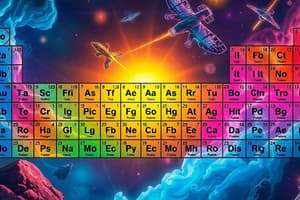Podcast
Questions and Answers
What was the main observation made by John Newlands regarding element properties?
What was the main observation made by John Newlands regarding element properties?
Newlands observed that the properties of the eighth element in a sequence resembled those of the first element.
How did Newlands compare the arrangement of elements to music?
How did Newlands compare the arrangement of elements to music?
Newlands compared the arrangement of elements to octaves in musical notes, where every eighth note resembles the first.
What limitation did Newlands face with his Law of Octaves?
What limitation did Newlands face with his Law of Octaves?
The Law of Octaves only worked well for lighter elements up to calcium and failed for heavier elements.
What are the triads and who identified them?
What are the triads and who identified them?
Give an example of a triad identified by Dobereiner.
Give an example of a triad identified by Dobereiner.
Why was Dobereiner's system of classification not successful?
Why was Dobereiner's system of classification not successful?
What relationship did the atomic masses of strontium, calcium, and barium have?
What relationship did the atomic masses of strontium, calcium, and barium have?
How many elements were known at the time of Newlands' proposal?
How many elements were known at the time of Newlands' proposal?
What was the significance of the elements chlorine, bromine, and iodine in Newlands' work?
What was the significance of the elements chlorine, bromine, and iodine in Newlands' work?
What did Newlands propose regarding the grouping of elements?
What did Newlands propose regarding the grouping of elements?
What was Robert Boyle's definition of an element?
What was Robert Boyle's definition of an element?
What classification system did Lavoisier introduce for elements?
What classification system did Lavoisier introduce for elements?
What is a major limitation of Lavoisier's classification of elements?
What is a major limitation of Lavoisier's classification of elements?
What are Dobereiner's triads?
What are Dobereiner's triads?
How does Dobereiner's law relate atomic mass to chemical properties?
How does Dobereiner's law relate atomic mass to chemical properties?
By the end of the 18th century, how many elements had been discovered?
By the end of the 18th century, how many elements had been discovered?
Why was it easier to study elements when only a few were known?
Why was it easier to study elements when only a few were known?
What characteristic properties differentiate metals from non-metals?
What characteristic properties differentiate metals from non-metals?
What role do trends in properties of elements play in the classification of elements?
What role do trends in properties of elements play in the classification of elements?
How many elements are known currently?
How many elements are known currently?




